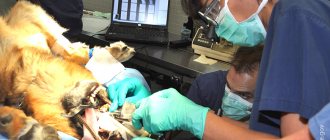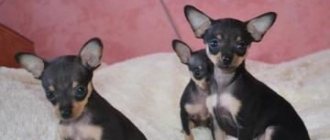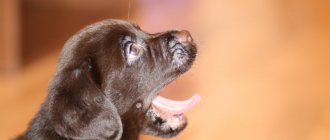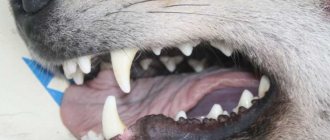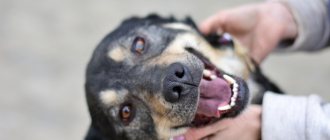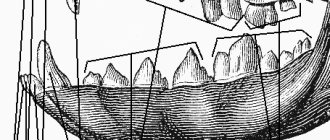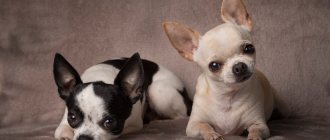Most people believe that animals, and especially dogs, simply cannot have any problems with their teeth. This is a big misconception. Dogs, although less often than people, suffer from malocclusion. Such a problem often calls into question both the health and career of the animal.
Unfortunately, most dog owners find out that their dog has an incorrect bite only at exhibitions, where a specialist will identify deficiencies during examination. For a dog performing service, the incorrect position of the teeth becomes a death sentence, completely excluding participation in exhibitions, the right to breed, as well as directly from performing service. That is why for dogs taking part in exhibitions and service dogs, in fact, like for any pet, impaired dental growth becomes an extremely serious problem. In fact, any dog should have healthy teeth and bite, because in some way, a dog with weak and problematic teeth is a contradiction in relation to its own natural purpose.
Dogs with short muzzles, also known as brachycephalics, and toy breeds are most likely to experience bite problems.
Orthodontics, a special branch of dentistry that specializes in the correction and prevention of dental growth disorders and bite defects, is designed to cope with such problems. The success of treatment depends on correct diagnosis, appropriate selection of treatment procedures and measures, and the correct use of special devices.
Although the field previously dealt exclusively with human bite problems, a field known as veterinary orthodontics has recently emerged. This branch is designed to cope with malocclusion in dogs of any age. The presence of special techniques for correcting the growth and incorrect position of teeth allows us to avoid many problems and complications associated with dental problems in pets.
Types of bite in dogs
There are several types of bite in dogs, namely:
· Normal bite, also known as scissor bite. This pattern of teeth arrangement received this name because of its resemblance to scissors: when the animal closes its jaws, the lower incisors are closely pressed to the back of the upper jaw. Thus, when closing, the pet’s teeth form a tight lock. This tooth structure is optimal for the vast majority of breeds. If such a scheme is violated, it means that the dog has a defect that prohibits it from participating in breeding (of course, provided that the animal is intended to participate in exhibitions or perform service). This selection rigidity is directly related to the fact that this type of bite is optimal and correct from a physiological point of view. It is this arrangement of teeth that allows the animal to chew food normally, protects against injuries to the teeth and gums, and also provides a strong and strong grip, which is extremely important for guard breeds.
· Malocclusion, also known as pincer bite. This type of bite is characterized by the fact that the pet’s lower and upper incisors form a single line and thus come into close contact with each other. It should be noted that these teeth bear most of the load for which they are not ready. As a result, they quickly wear down. However, a straight bite has almost no effect on the remaining teeth. This arrangement of teeth can be both hereditary and secondary. Acquired overbite can occur due to constant exposure to the animal's teeth, especially at an early age, for example, during play.
· Underbite. This arrangement of teeth causes many more problems than, for example, a straight or pincer bite. Underbite is characterized by the fact that the lower incisors are positioned in such a way that they cannot reach the line of the upper incisors, which, in turn, leads to rapid wear of the canines and molars.
· An underbite, also known as a bulldog overbite. As a rule, it is formed due to the dog's muzzle being too short. This structure of the skull leads to the fact that the lower jaw protrudes significantly forward and opens the lower incisors, and in some cases, the fangs. Underbite, being a defect for the vast majority of breeds, remains the norm for boxers and bulldogs.
Limbs
The forelimbs are vertical, parallel to each other, symmetrical. The shoulders are moderately muscular and level. The angles of the glenohumeral joints have a well-defined outline. Forearms are straight, optimal length. Pasterns strong, flexible, slightly sloping.
The Chihuahua's hind limbs are muscular, symmetrical, located parallel and vertical relative to each other, and are in perfect harmony with the forelimbs in movement. The hock (tarsal) joints are short, with well-developed Achilles tendons. The hocks are vertical, straight, and widely spaced.
The paws (feet) are small and oval in shape. The fingers are widely spaced, but not splayed. Dewclaws (fifths) are not welcome. Claws of optimal medium length, well curved. The paw pads are elastic, soft and developed.
Causes of malocclusion in dogs
Malocclusion in dogs is often a hereditary trait. That is why one of the main tasks of breeders is to exclude individuals with impaired dental growth from the number of individuals suitable for reproducing offspring.
However, genetic origin is far from the only factor that can affect a pet’s bite. Often, deviations occur in animals that were raised without the necessary nutritional or care standards. Such factors may include:
- lack of minerals in the dishes that the dog eats during pregnancy or during feeding;
- mechanical damage to the jaw (problems are especially likely to occur if the injury was received at a young age);
- active games that involve serious stress on the animal’s teeth;
- delayed removal of baby teeth, discrepancy between their shapes and sizes in relation to permanent ones.
Dog owners should remember that it is extremely difficult to change the bite of an adult dog. It is much easier to pay due attention to preventive measures to avoid all of the above problems with your pet’s bite.
Correcting malocclusion in dogs
In principle, the process of correcting bites in dogs is similar to procedures designed to correct bites in humans. Conventionally, all methods for correcting tooth growth can be divided into the use of braces, that is, non-removable devices, and removable aligners, brackets and other structures.
Transparent aligners
One of the latest breakthroughs in animal orthodontics is removable mouth guards, which were originally made for humans. They are completely transparent, and their main advantage for the dog is the fact that they can be removed while eating and, for example, brushing the animal’s teeth. To take an accurate impression, the doctor will only need a one-time anesthesia.
The mechanism of action of mouth guards is quite simple - they fit very tightly to the teeth and exert pressure in the required direction. About 2-3 times a month the mouth guard is replaced with a new, slightly different device. A difference of a couple of millimeters will allow the new aligner to continue to move the teeth. Gradually, the teeth fall into the right place. Throughout the process, doctors make intermediate impressions to monitor changes in detail.
The animal needs to wear mouth guards for as many hours a day as possible. These devices require maintenance, so pet owners must clean and rinse them. It should be noted that such mouthguards have not yet gained total popularity due to the price of procedures and devices. A good alternative is the so-called removable braces, which look like a rubber ring. The only drawback of this design is the fact that they can only have a really noticeable effect on puppies.
Fixed structures for changing a dog's bite
As for non-removable devices, they are installed for the entire duration of the required treatment. In this case, the specialist often adjusts the plate, changes the degree of rotation and inclination of the teeth.
Braces are a well-known orthodontic device that consists of small locks and dense wire. They are attached to the teeth using a special dental adhesive. There are several variations on the theme of wire shape. Since it is responsible for the pressure exerted on the teeth, the choice of its characteristics will depend on the individual characteristics of the animal's problem. One of the main advantages of braces is that the wires can be changed.
In order for braces to properly affect the condition of the pet’s teeth, owners will need to follow absolutely all recommendations for caring for this device, avoid damage, for example, during play, and also limit the consumption of solid food, such as bones, as much as possible.
Braces cannot be installed if the dog suffers from allergic reactions, periodontitis, tumors or ulcerative stomatitis.
When do baby teeth appear?
Chihuahua puppies are born toothless. Milk teeth begin to erupt 2 weeks after birth. Sequence of cutting:
- First, a pair of central incisors emerge in the lower row, then in the upper.
- The lateral incisors are cut next.
- Behind them the fangs change (in any order).
- The premolars are cut last.
The growth of a Chihuahua's milk teeth lasts 2-3 months. Their development ends by 4 months of age.
Preventing malocclusion in dogs
If malocclusion is not a hereditary trait, problems with the jaw and teeth can be avoided by following simple recommendations. It is worth paying attention to the fact that preventive measures should be taken at a very young age.
First of all, owners need to pay maximum attention to the high-quality and nutritious diet of their pet. At a young age, you can feed your puppy dry food only if it is specifically designed for this age category. Their main advantage is that they are made according to a specific pattern designed to satisfy all the needs of a growing organism. They include all the essential vitamins and minerals that allow the animal's bones to grow at a normal rate.
If you prefer to feed your young pet natural food, you need to add minerals and vitamins to his diet. There are special additives for these purposes.
What to do if your dog has an abnormal bite
However, you should not overfeed your dog with these supplements. The ideal dosage should be calculated together with a specialist.
Remember, a young dog's jaw and teeth need regular examination. They require especially careful observation during the period of change of baby teeth (usually happens at six months of age). As a rule, this natural process goes away on its own and does not cause any complications. However, there are also cases when this stage becomes the beginning of future problems with the animal’s bite. If you notice that your dog's molars are unable to grow due to his baby teeth, you should immediately consult a doctor. A specialist, as a rule, in such cases advises purchasing specially designed toys that accelerate the process of baby teeth falling out. It is also possible to have interfering teeth removed by a veterinarian. If the bite has already begun to deform, the position of the teeth can be corrected at a young age using a special rubber ring, which can be installed by veterinarians who specialize in dental problems.
Scissor or regular bite in dogs
I don't need a dentist!
The words “dog bite” usually refer to the way the dog’s upper and lower jaws, as well as individual teeth, fit together. The form of closure depends on the structure of the animal’s muzzle and the entire skull as a whole. The formation of the bite is also influenced by the following factors:
- disproportionate sizes of the jaw and teeth (for example, a too narrow jaw with large teeth that do not fit on it);
- anomalies when changing milk teeth to permanent ones (the temporary tooth did not fall out in time, without freeing up its place for the permanent one, which, in turn, grew where it was necessary, as a result of which the dentition was disrupted);
- poor heredity (if parents suffer from malocclusion, then one can predict that their offspring will suffer the same fate);
- injury to the bones of the skull;
- excessive stress on the teeth at the time of their growth (tug of war or similar games and activities);
- unbalanced diet that does not provide the dog with the required amount of vitamins and other nutrients;
- various developmental disorders not directly related to lifestyle.
Disadvantages (defects)
Disadvantages are divided into 2 categories:
- minor;
- serious.
This refers to weakly or strongly expressed deviations in conformation from the standard described by the FCI, which are assessed by an expert depending on the degree of severity, impact on the welfare and health of the dog. Serve as a legitimate basis for underestimating the price at the exhibition.
MINOR:
- incomplete set of teeth, polyodontia, double dentition (deciduous teeth retained);
- slightly long body;
- pointed ears;
- spinal deformity (hunchback, arched back);
- excessively sloping croup;
- shortened neck;
- flat or narrow chest;
- loose elbows;
- short or curled tail, incorrect placement;
- short or long limbs;
- incorrect (inappropriate) stance of the hind limbs (wide, narrow, barrel-shaped).
SERIOUS:
- bulging, small, or deep-set eyes;
- long (sharp) muzzle;
- malocclusion (overshot, undershot);
- narrow, wide or flat skull;
- The kneecap (patella) is displaced relative to the femur.
During breeding, there is a possibility of inheriting defects genetically, so the participation of defective dogs in breeding is undesirable. However, it is not prohibited, unlike disqualified ones.
Does your Chihuahua dog meet the standard of the International and Russian Cynological Federation? And why is this important to you?
What types of bites are there?
The correct bite in dogs is a scissor or scissor bite: at the moment the jaws join, the back teeth of the upper teeth meet as tightly as possible with the incisors of the lower one. For a dog of any breed, even a slight deviation from this standard is a serious defect that puts an end to the individual as a breeding animal, that is, it is not allowed for breeding.
Underbite is a pathology in which the molars and canines of both jaws are quickly worn away due to the fact that they fit too tightly to each other. If you look at the picture, it becomes noticeable that with this pathology, the incisors of the dog’s lower jaw do not reach the line of the incisors located above.
Many people wonder: how to correct an undershot bite in a puppy and is it even possible in principle? Fortunately, today it is possible to straighten crooked teeth not only in humans, but also in animals. Of course, this is a rather complex and expensive undertaking, but the result usually exceeds all expectations. The procedure is described in more detail below.
Malocclusion in dogs, also called pincer bite, can be either congenital or acquired (for example, due to certain types of games such as tug of war). “Thanks to” incorrectly positioned jaws, the incisors on top and bottom rest against each other, as a result of which excessive load is placed on them and they are quickly worn out. Molars and canines, as a rule, are not affected.
Snacking is the norm only for some breeds (for example, bulldogs). For all other dogs it is considered a pathology. The reason for the formation of an undershot is that the facial bones of the skull are not long enough, which is why the lower jaw of the animal protrudes noticeably forward.
How to fix a dog's snacking? This defect is corrected in the same way as underbite - with the help of braces. Unfortunately, this is not possible in all cases.
Chihuahua breed standard according to RKF
According to the RKF standard, the Chihuahua's exterior looks harmonious and elegant. The dog is tightly built, agile, restless, with a curious expression on its face. She has excellent reactions and fearlessness. In the breed description there are three classes depending on size:
Only the first species can participate in breeding, since only standard Chihuahuas are capable of bearing puppies and feeding them.
Dimensions and weight
Among the main parameters of the breed is weight. Dogs reach their maximum weight at one year of age. The ideal body weight is 1.3-3 kg for males and 1.5-2.8 kg for females. If the indicator is less than 500 g or more than 3.1 kg, this is considered a defect and becomes a reason for disqualification from competitions. Depending on the species, the weight of a Chihuahua varies:
- standard – from 1.5-3 kg;
- mini – 1-1.5 kg;
- micro – 0.5-1 kg.
The standard does not specify body length. The height at the withers varies from 15 cm to 23 cm.
Head
An adult Chihuahua has a standard skull shape - apple-shaped. The transition from the forehead to the nose (stops) is clearly defined, it is wide, deep and even hangs over the muzzle. The nose is small, slightly directed upward, and can be any color. In profile, it is clearly visible that the Chihuahua's muzzle is straight, with a wide base, and smoothly tapers towards the tip of the nose. Cheekbones are small, not protruding. The lips do not sag, fit tightly, and are dry. Bite: straight or scissor bite.
The anatomy of the Chihuahua skull has a peculiarity - the presence in some adults of an open fontanel up to 2 cm wide. Since 2010, according to the standard, its presence is classified as a defect.
Eye color
The Chihuahua's eyes are large, round in shape, but without bulge. Their look is interested and very expressive. The iris is normally a dark shade, although lighter ones are not considered a breed defect. In most cases, cream, red and fawn sneezes have black eyes and the same nose. Hazel, amber, blue or green irises in dogs with beige or apricot coats.
Chihuahuas normally have large ears. They are slightly spaced, open, and located at an angle of 45⁰ in relation to the head. They are wide at the base and narrow towards the tips. When alert, they rise and become directed upward.
In ordinary Chihuahuas, the inner surface of the ears is almost bald, the outer surface is covered with short hairs. Long-haired dogs have thick fur on their ears, which is not required to be cut according to the standard.
In size they can be large, medium and small. Excessively pointed or rounded ears are a defect in conformation.
Normally, male dogs have a thicker neck than female Chihuahuas. Her top line is without dewlap. The long-haired species has a voluminous mane around the neck, which is supported by the breed standard.
The body of the Chihuahua is balanced and looks harmonious. Chest with rounded ribs. It should not be too flat or round in shape. In lateral view it normally extends to the elbows. The bottom is clearly defined, the stomach is tucked, slight sagging is acceptable, but not desirable. There are two types of standard Chihuahuas, differing in body type:
- Cobbies are stocky, dense, with a large head and eyes. Their chest is large, their legs are muscular, and their tail is powerful.
- Deer is a medium-sized Chihuahua with the appearance of a fawn, a proportional body, and long legs.
Back
The Chihuahua's withers are not clearly expressed. The back is short but strong, with a muscular loin. The croup is wide and straight, slightly sloping is allowed by the standard.
The limbs of miniature dogs are slender. The Chihuahua's paws are small, oval, loose, with well-developed elastic pads.
Front
The Chihuahua's front legs are straight, parallel, and vertical in profile. There are pronounced muscles on the shoulder blades, the angles of the joints are clearly visible. The elbows move freely and are close to the ribs. The forearms of the forelimbs are straight, the pasterns are sloping and springy. The paws are small, with curved, moderately long claws.
Rear
According to the standard, the hind limbs are long, straight, parallel to each other. The hock joints are short. The hocks are straight, set wide apart, and the Achilles tendons are developed. Paws are oval, small, dewclawed toes are undesirable.
Tail
The tail of Chihuahuas is flat, of medium length, and high. It is wide at the base and becomes narrower towards the end. A distinctive feature of the breed is that when moving, the dog carries it high straight or with a slightly curved sickle. At rest, it is lowered and resembles a hook. The length of the coat depends on the type of Chihuahua. In long-haired individuals, the hairs on the tail form a plume.
Correcting malocclusion in dogs
It all depends on what result the dentist wants to achieve: expand, spread or move the teeth. By applying pressure to the correct teeth, braces cause them to gradually move to where they would be if the dog's jaw were developing normally. Since the process of moving teeth takes a long time, the system is installed for a long period (from several months).
There are also contraindications:
- gingivitis,
- stomatitis,
- allergy,
- formations of various types in the oral cavity,
- inability to meet requirements regarding oral hygiene.
While wearing a wire structure, the dog needs careful, daily oral care. The owner will have to devote his time to regular hygiene procedures, since if the dog’s teeth are not brushed during this period, they will not only very quickly become covered with tartar, but will also be subject to carious destruction. All this will happen “thanks” to food particles stuck between the structural elements.
Before you decide on a correction, you should think carefully about whether your pet needs it. Remember that even after successful correction of the bite, the dog will not be allowed to participate in exhibitions or for breeding, since all of its jaw pathologies will be passed on to its future offspring.
On the other hand, if the dog suffers from the inability to chew food normally or from constant injury to the tongue, lips, cheeks and gums, then he cannot do without treatment.
All materials in the section “Taking care of your pet’s teeth.”
See also: When do puppies' teeth change? RKF - obtaining a pedigree The dog is shedding - what to do?
How to brush your Chihuahua's teeth at home
Before you start cleaning, you need to let the puppy sniff the brush and let it lick the paste. It is better to brush a puppy’s teeth with a small, soft rubber brush; for an adult dog, with a toothbrush with nylon bristles. Procedure:
- Spread your pet's lips;
- Apply a brush with toothpaste to your teeth;
- Make circular or scraping (top to bottom) movements with it;
- Rinse off the paste with a stream of water (if required);
- After cleaning, massage your gums with a massager brush.
